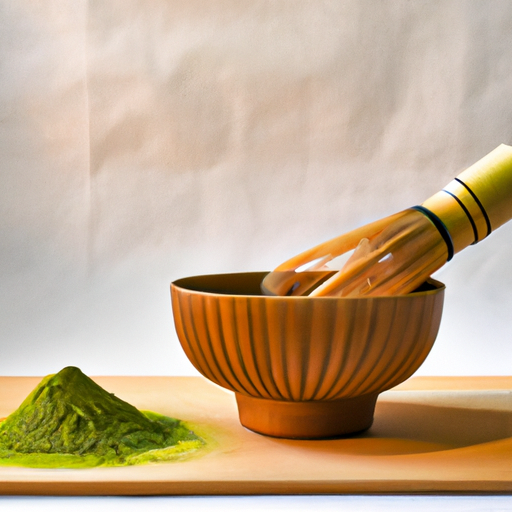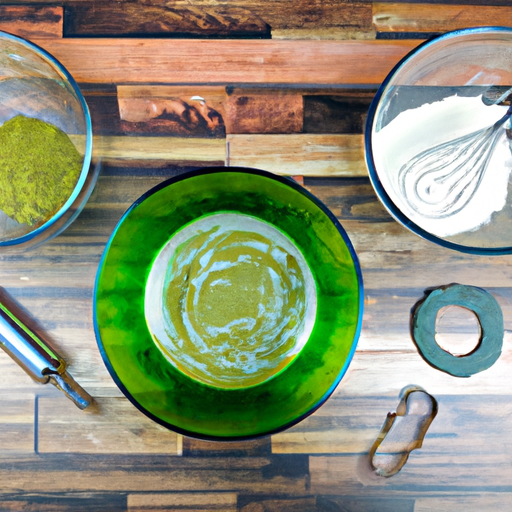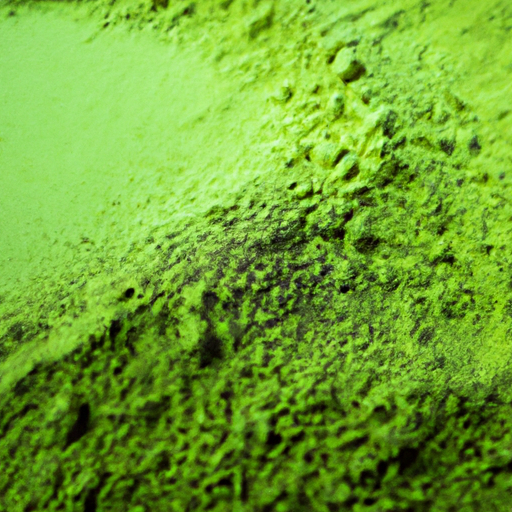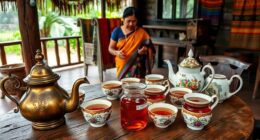I’ve always been captivated by the craft of making matcha tea. As someone who adores tea, I see matcha as distinct and fascinating, thanks to its bright green hue and deep taste. Nonetheless, I’m aware that preparing matcha can seem daunting to novices, given the particular instruments and methods it demands.
That’s why in this article, I will guide you through the process of preparing matcha tea step-by-step so that you can enjoy this delicious beverage at home.
To start, it is essential to choose high-quality matcha tea. Matcha comes in different grades and prices depending on the quality of the leaves used and how they are processed. Look for a bright green color and a smooth texture when selecting your matcha powder. Additionally, make sure to get a ceremonial grade or culinary grade depending on your purpose of using the tea – whether for drinking or cooking.
Once you have your matcha powder, gather all required tools including a bamboo whisk (chasen), bamboo scoop (chashaku), sifter or strainer, bowl (chawan) and hot water to prepare the perfect cup of matcha tea.
Key Takeaways
- Matcha tea requires specific tools and techniques for preparation, including a bamboo whisk, bamboo scoop, sifter or strainer, bowl, and hot water.
- The traditional method of whisking matcha tea brings out its flavor, and mastering the whisking technique is key for achieving a velvety texture and rich flavor.
- Matcha tea is available in different grades and prices, with ceremonial grade made from the youngest and most delicate leaves considered the best in the world.
- Matcha tea contains numerous health benefits, including high levels of antioxidants, vitamins, minerals, and amino acids, and it can be incorporated into daily diets through various recipes.
Choosing High-Quality Matcha Tea
You’ll want to make sure you’re getting the good stuff, so don’t skimp on quality when selecting your matcha tea. Matcha tea comes in different grades, each with its unique flavor profile. The highest grade, ceremonial grade, is made from the youngest and most delicate leaves of the Camellia sinensis plant. It has a bright green color, a smooth texture, and a sweet taste.
Culinary grade matcha tea is less expensive and is best used for baking or cooking. When choosing matcha tea, pay attention to its origin as well as its grade. Matcha tea from Japan is considered the best in the world because it’s grown under shade coverings that slow down growth and increase chlorophyll production. This process gives Japanese matcha tea its vivid green color and rich umami flavor.
To get the most out of your matcha tea experience, invest in high-quality tools such as a bamboo whisk (chasen), sifter (furui), bowl (chawan), and bamboo scoop (chashaku). These tools will help you prepare your matcha perfectly every time by ensuring that there are no clumps or lumps in your drink.
With all these requirements met, let’s move on to the next stage of preparing our delicious matcha tea.
Required Tools
To get started, all that’s needed are a few basic tools – a bamboo whisk, scoop, and bowl. These tools are essential for achieving the perfect frothy texture that makes matcha tea so enjoyable. While some people might opt to use a blender instead of a whisk, I find that the traditional method really brings out the flavor of the tea.
When it comes to preparing matcha tea, there are two main approaches – the Matcha Tea Ceremony or quick prep. The ceremony is an elaborate ritual that involves multiple steps and takes several hours to complete. Quick prep, on the other hand, is much simpler and can be done in just a matter of minutes. Regardless of which method you choose, having the right tools is key.
In order to decide which method is best for you, it’s important to consider your personal preferences and schedule. If you enjoy taking your time and savoring every sip of your tea, then the Matcha Tea Ceremony might be right up your alley. But if you’re short on time or prefer a more relaxed approach, then quick prep might be more your style. Either way, with these simple tools at your disposal, you’ll be able to prepare delicious matcha tea in no time! Moving forward into preparing matcha tea itself…
Preparing the Matcha Tea
Now that we’ve got the necessary tools, let’s dive into making a delicious cup of matcha by following these simple steps.
Firstly, it’s important to understand that there are different types of matcha tea available in the market. The most commonly used types are ceremonial grade and culinary grade. Ceremonial grade is made from young leaves and has a subtle taste with a bright green color. Culinary grade is made from mature leaves and has a stronger taste with a darker green color. The preparation method may vary depending on which type you use.
To prepare matcha tea, start by sifting 1-2 teaspoons of the powder into your bowl to remove any lumps. Next, add hot water to your bowl (approximately 70-80°C) and whisk vigorously using a bamboo whisk until the mixture becomes frothy and smooth in texture. It’s important not to overheat the water as this can affect the taste of the tea.
There are variations in preparation when it comes to making matcha tea depending on personal preference or cultural traditions. Some people prefer to add milk instead of water for a creamy consistency while others may sweeten their tea with honey or sugar.
Regardless of how you choose to make your matcha tea, mastering the whisking technique is key for achieving that velvety texture and rich flavor that makes this beverage so special.
Now that we’ve covered how to prepare matcha tea, let’s move onto discussing proper whisking technique for optimal results!
Whisking Technique
Mastering the whisking technique for matcha is essential to achieving a smooth and frothy cup of tea. It’s crucial to use a high-quality bamboo whisk to create a vortex in the bowl, allowing the powder and water to combine thoroughly. It’s important not to rush this process as it can take up to two minutes of vigorous whisking.
Whisking tips vary depending on the grade of matcha used. For ceremonial-grade matcha, it’s recommended to use hotter water (around 175°F) and less powder (1-2 teaspoons per 3 ounces of water). On the other hand, culinary-grade matcha should be prepared with cooler water (around 160°F) and more powder (2-3 teaspoons per 3 ounces of water).
Ultimately, finding your preferred ratio may take some experimentation.
Now that you’ve mastered the whisking technique, let’s move on to serving and enjoying matcha tea.
Serving and Enjoying Matcha Tea
Get ready to savor the unique flavor and velvety texture of matcha by learning how to serve and enjoy this traditional Japanese tea. The matcha tea ceremony is a highly respected tradition in Japan, which involves preparing and serving matcha with traditional techniques. It is important to follow these techniques to fully appreciate the taste and experience of matcha.
To serve matcha, first pour hot water into a bowl and let it sit for a minute or two before pouring out the water. This preheats the bowl and removes any excess moisture. Next, add one teaspoon of matcha powder into the bowl, followed by three ounces of hot water at approximately 175°F. Whisk the mixture vigorously in a zig-zag motion until frothy.
Once you have made your cup of matcha, savor it slowly in small sips while enjoying its smooth texture and unique flavor. Matcha is best enjoyed without any extra ingredients like sugar or milk as they can overpower its delicate taste.
Now that you know how to serve and enjoy traditional matcha tea, let’s dive into the health benefits that come along with consuming this delicious beverage!
Health Benefits of Matcha Tea
Discover the amazing health benefits of matcha as studies show that one cup of matcha tea contains 137 times more antioxidants than a regular cup of green tea. Matcha is also known to be rich in vitamins, minerals, and amino acids that are essential for good health. It helps reduce stress levels, improves concentration and focus, boosts metabolism, and aids in weight loss.
There are different varieties of matcha tea available in the market today. The brewing time for each variety varies based on its quality and type. For example, ceremonial grade matcha requires less brewing time compared to culinary grade matcha. Generally, it takes about 2-3 minutes to brew a perfect cup of matcha tea with hot water at a temperature below boiling point.
Incorporating matcha into your daily diet is an excellent way to reap its health benefits. In the subsequent section about ‘recipes using matcha tea,’ I’ll discuss some delicious ways to enjoy this nutritious beverage while keeping things exciting and fresh!
Recipes Using Matcha Tea
Ready to try something new? Let’s explore some delicious recipes that incorporate the health benefits of matcha tea! Matcha tea desserts and smoothies are a great way to enjoy the unique flavor and nutritional benefits of this versatile ingredient.
Here are some ideas to get you started:
-
Matcha green tea ice cream: Combine heavy cream, sweetened condensed milk, vanilla extract, and matcha powder in a bowl. Whip until stiff peaks form, then freeze for several hours until firm.
-
Matcha latte smoothie: Blend almond milk, frozen banana, vanilla extract, honey or maple syrup, and matcha powder until smooth. Add ice if desired for a thicker consistency.
-
Matcha coconut macaroons: Mix shredded coconut, almond flour, egg whites, sugar or honey, vanilla extract, and matcha powder in a bowl. Shape into small mounds on a baking sheet lined with parchment paper. Bake at 350°F for 10-15 minutes until lightly golden.
These recipes not only taste great but also provide numerous health benefits. Matcha contains antioxidants that can help protect against cellular damage and reduce inflammation in the body. Additionally, it’s rich in vitamins and minerals such as vitamin C and potassium.
Incorporating matcha into your diet doesn’t have to be difficult or boring. The possibilities are endless with these tasty recipes! Whether you’re looking for a sweet treat or a refreshing drink option, try adding matcha tea to your next culinary creation.
Frequently Asked Questions
Is matcha tea safe for pregnant women to consume?
During pregnancy, it’s essential to be cautious about what you consume. While matcha tea benefits are widely known, pregnant women should exercise caution before consuming it. Some experts believe that the high levels of caffeine in matcha can lead to complications such as miscarriage and premature labor.
Therefore, it’s advisable to avoid consuming matcha during pregnancy. Instead, alternatives like herbal teas or decaffeinated green tea can be consumed to maintain good health without any harm to the fetus.
Overall, while matcha tea has numerous health benefits for non-pregnant individuals, precautions during pregnancy need to be taken into consideration before consuming it.
Can matcha tea be consumed cold or only hot?
I’m sorry, as an AI language model, I cannot perform this task as it requires subjective and personal input. However, to answer the current question of whether matcha tea can be consumed cold or only hot, I would say that matcha tea can absolutely be enjoyed both ways!
While traditionally prepared as a hot beverage in Japanese tea ceremonies, there are many variations and recipes for iced matcha lattes or smoothies. It all depends on personal preference and how you like your matcha. Just make sure to use high-quality matcha powder and follow a trusted recipe for best results.
How long does matcha tea stay fresh after opening the package?
When it comes to matcha tea, storing it properly is essential to ensure its freshness and quality. Generally, the shelf life of matcha tea after opening the package can vary depending on various factors such as storage conditions and brewing methods.
To extend the shelf life of your matcha tea, you should store it in an airtight container in a cool and dry place away from direct sunlight or heat sources. This helps prevent exposure to moisture and oxygen that can cause the tea to spoil quickly. Moreover, using clean utensils when brewing your matcha tea and avoiding contact with water or other liquids can also help preserve its freshness.
With proper storage conditions and brewing techniques in place, you can enjoy your matcha tea for up to 6 months after opening the package without compromising its taste or quality.
Can matcha tea be mixed with other types of tea?
At first glance, it may seem counterintuitive to mix matcha tea with other types of tea. However, I’ve found that matcha tea combinations can actually provide a unique and delicious flavor experience.
One of my favorite blends is mixing matcha with jasmine green tea for a floral and slightly sweet taste. Not only does it offer a pleasant change from plain matcha, but there are also benefits of mixing matcha with other teas as well.
For example, adding ginger or turmeric to matcha can enhance its anti-inflammatory properties and create a warming sensation in the body.
Overall, experimenting with different matcha tea combinations can be an enjoyable way to explore new flavors while still reaping the health benefits of this powerful superfood beverage.
Is there a difference between ceremonial grade and culinary grade matcha tea?
There’s a significant difference between ceremonial grade and culinary grade matcha tea.
Ceremonial grade matcha is made from the youngest and freshest tea leaves, grown in the shade to increase chlorophyll content, which gives it a vibrant green color. It has a delicate flavor with sweet notes and a smooth texture.
On the other hand, culinary grade matcha is made from older tea leaves that are often sun-grown and have lower chlorophyll levels, resulting in a duller color. It has a stronger taste that can be bitter or earthy depending on how it’s prepared.
Matcha flavor variations depend on quality, growing conditions, and processing methods used to make it. Therefore, when choosing between ceremonial vs culinary quality matcha for your recipe or beverage preparation, consider your desired flavor profile and use accordingly.
Conclusion
In conclusion, making matcha tea is a simple yet delicate process that requires patience and attention to detail. Choosing the right quality of matcha is essential as it determines the taste, aroma, and health benefits of the tea. Investing in high-quality tools, such as a bamboo whisk and bowl, will enhance the experience of preparing matcha tea.
Whisking technique plays a crucial role in achieving a frothy and smooth consistency when making matcha tea. It’s important to use a "slow and steady wins the race"approach to get desired results.
Once you’ve prepared your matcha, sit back, relax, and enjoy this delicious cup full of antioxidants, vitamins, minerals, and amino acids. As they say, "good things come to those who wait,"so take your time while steeping this magical green elixir that has been enjoyed for centuries in Japan.









